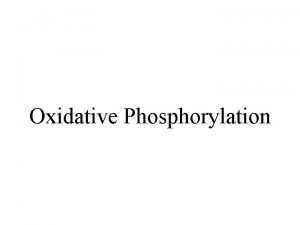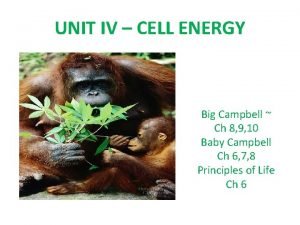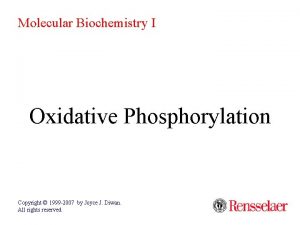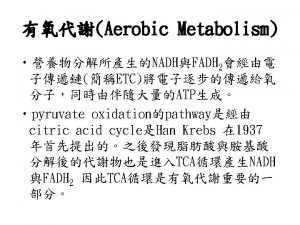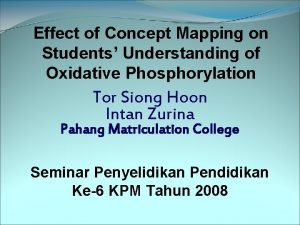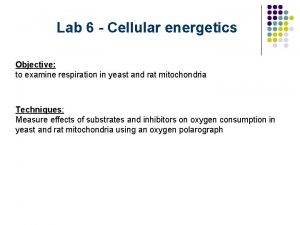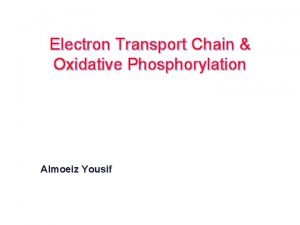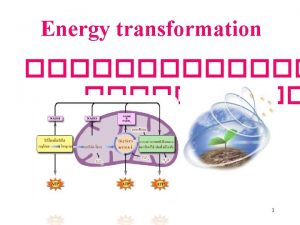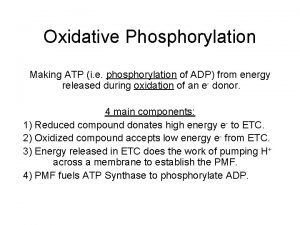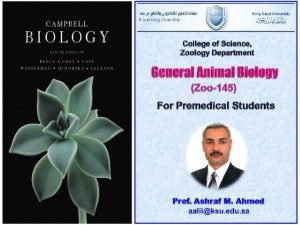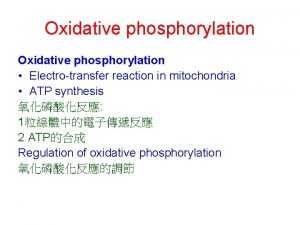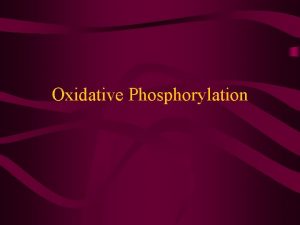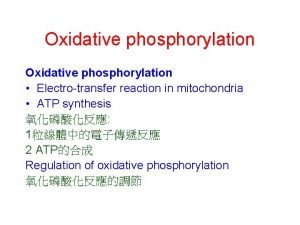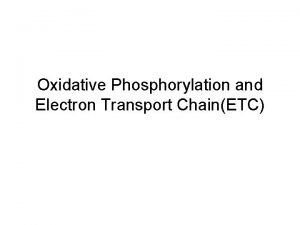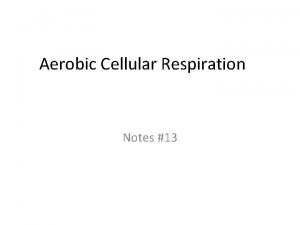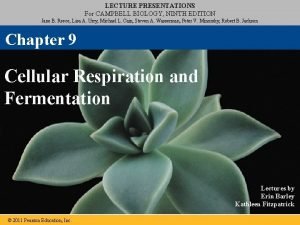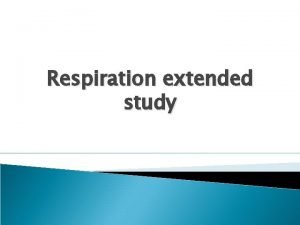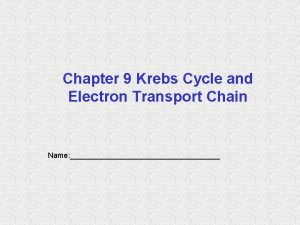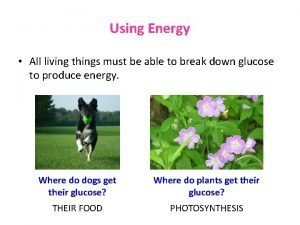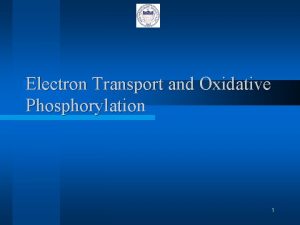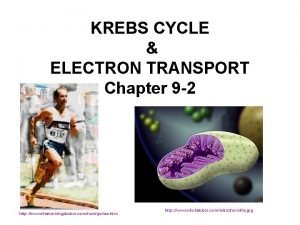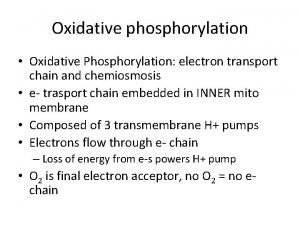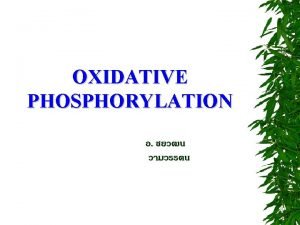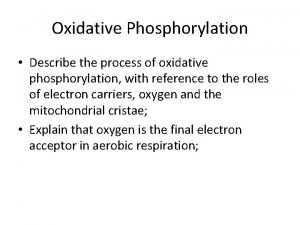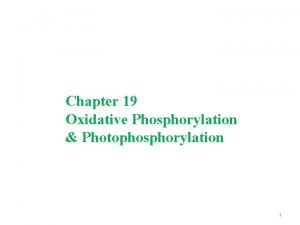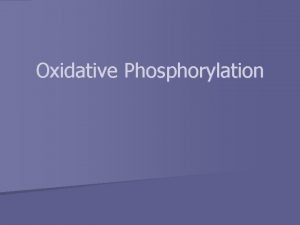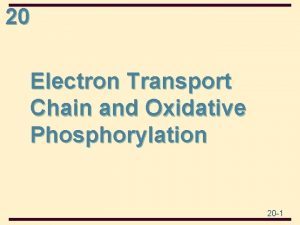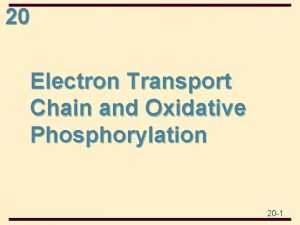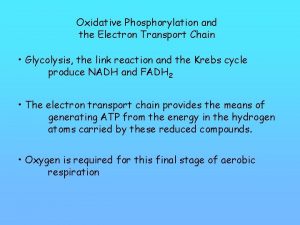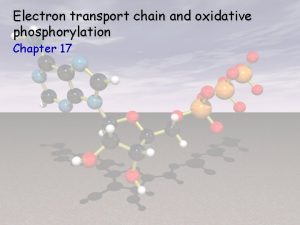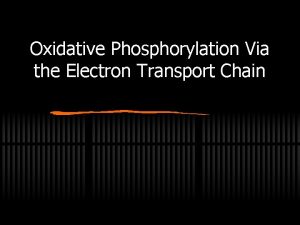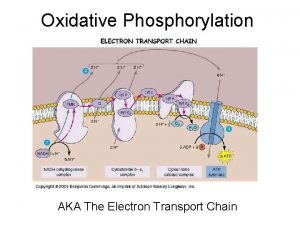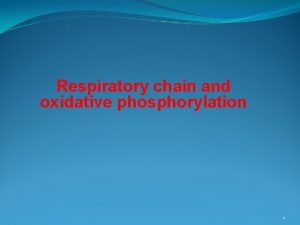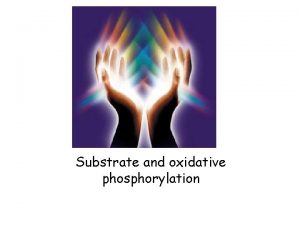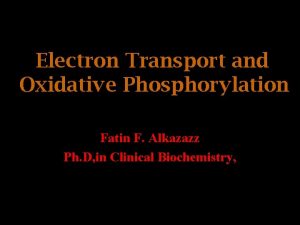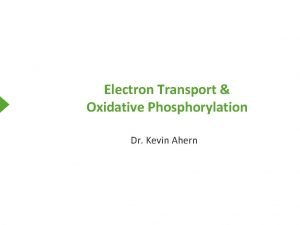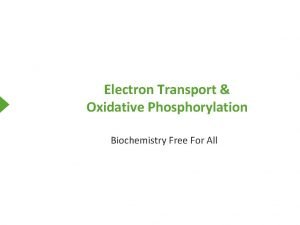ELECTRON TRANSPORT CHAIN OXIDATIVE PHOSPHORYLATION The electron transport






















- Slides: 22

ELECTRON TRANSPORT CHAIN OXIDATIVE PHOSPHORYLATION

• The electron transport chain(ECT) in the mitochondrion is the site of oxidative phosphorylation in eukaryotes. The NADH and succinate generated in the citric acid cycle are oxidized, providing energy to power ATP synthase. ETC is a series of complexes that transfer electrons from electron donors to electron acceptors via redox (both reduction and oxidation occurring simultaneously) reactions, and couples this electron transfer with the transfer of protons (H+ ions) across a membrane. This creates an electrochemical proton gradient that drives the synthesis of adenosine triphosphate (ATP). The final acceptor of electrons in the electron transport chain during aerobic respiration is molecular oxygen although a variety of acceptors other than oxygen such as sulfate exist in anaerobic respiration

• In eukaryotes, an important electron transport chain is found in the inner mitochondrial membrane where it serves as the site of oxidative phosphorylation through the action of ATP synthase. It is also found in the thylakoid membrane of the chloroplast in photosynthetic eukaryotes. In bacteria, the electron transport chain is located in their cell membrane as there is no mitocondria.

• The function of the electron transport chain is to produce a transmembrane proton electrochemical gradient as a result of the redox reactions. At the mitochondrial inner membrane, electrons from NADH and FADH 2 pass through the electron transport chain to oxygen, which is reduced to water. ATP synthase converts this mechanical work into chemical energy by producing ATP which powers most cellular reactions. In most organisms the majority of ATP is generated in electron transport chains. This entire process is called oxidative phosphorylation, since ADP is phosphorylated to ATP using the energy of hydrogen oxidation in many steps.


• According to the chemiosmotic coupling hypothesis, proposed by Nobel Prize in Chemistry winner Peter D. Mitchell, the electron transport chain and oxidative phosphorylation are coupled by a proton gradient across the inner mitochondrial membrane. The efflux of protons from the mitochondrial matrix creates an electrochemical gradient (proton gradient). This gradient is used by the FOF 1 ATP synthase complex to make ATP via oxidative phosphorylation.

In eukaryotes • NADH is the most important electron donor. The associated electron transport chain is • NADH → Complex I → Q → Complex III → cytochrome c → Complex IV → O 2 where Complexes I, III and IV are proton pumps, while Q and cytochrome c are mobile electron carriers. The electron acceptor is molecular oxygen.

• In bacteria, the electron transport chain is located in their cell membrane. . The electron transport chain consists of a spatially separated series of redox reactions in which electrons are transferred from a donor molecule to an acceptor molecule.

In prokaryotes (bacteria and archaea) the situation is more complicated, because there are several different electron donors and several different electron acceptors. The generalized electron transport chain in bacteria is: Donor ↓ ↓ dehydrogenase → quinone → bc 1 → cytochrome ↓ oxidase(reductase) ↓ Acceptor

• Note that electrons can enter the chain at three levels: at the level of a dehydrogenase, at the level of the quinone pool, or at the level of a mobile cytochrome electron carrier. Individual bacteria use multiple electron transport chains, often simultaneously. Bacteria can use a number of different electron donors, a number of different dehydrogenases, a number of different oxidases and reductases, and a number of different electron acceptors. For example, E. coli (when growing aerobically using glucose as an energy source) uses two different NADH dehydrogenases and two different quinol oxidases, for a total of four different electron transport chains operating simultaneously.

• A common feature of all electron transport chains is the presence of a proton pump to create a transmembrane proton gradient. Bacterial electron transport chains may contain as many as three proton pumps, like mitochondria, or they may contain only one or two. They always contain at least one proton pump.

Inhibitors of Electron Transport: • These are the inhibitors that arrest respiration by combining with members of the respiratory chain, rather than with the enzymes that may be involved in coupling respiration with ATP synthesis. They appear to act at 3 loci that may be identical to the energy transfer sites I, II and III. The given below are the inhibitors of Electron transport chain.

Inhibitors of Electron Transport: • 1. Rotenone: • It is the non-toxic inhibitors of Electron transport chain. • These compound extracted from roots of tropical plant Derris elliptica and Lonchoncarpus nicou. • It binds at Complex I between Fe-S protein and Ubiquinone. • This is non-toxic to mammals because poorly absorbed. Shows toxic effect in fishes.

Inhibitors of Electron Transport: • 2. Piericidin A: • It is an Antibiotic. It is produced by species of streptomyces. • The action is similar to Rotenone. • 3. Barbiturates (Amytal, Seconal): • It blocks NADH dehydrogenase and Coenzyme. Q • 4. Antimycins: • These are antibiotic, produced by Streptomyces. IT inhibits around site II and block electron flow between cytochromes b and c 1, which prevents ATP synthesis coupled to the generation og a proton gradient. at site II.

Inhibitors of Electron Transport: • 5. Dimercaprol: It is identical in action to the antimycins. • 6. Cyanides: The cyanide ion (CN–) combines tightly with cytochrome oxidase, leading to • 7. Azide: Azide blocks the electron flow between the cytochrome oxidase complex and oxygen. Azide reacts with the ferric form (Fe 3+) of this carrier. • 8. Hydrogen Sulfide: H 2 S is toxic, with disagreeing odour gives warning. It inhibits Cytochrome Oxidase. • 9. Carbon Monoxide: It blocks between cytochrome oxidase and Oxygen. It inhibits Fe 2+

Inhibitors of Oxidative Phosphorylation: • 1. Oligomycins: • Is a polypeptide antibiotic are obtained from various species of “Streptomyces. • They inhibit the transfer of high-energy phosphate to ADP and also inhibit electron transfers coupled to phosphorylation. The antibiotic is potent inhibitor to ATP synthase complex. • 2. Rutamycin: • This antibiotic also inhibits both ETC and oxidative phosphorylation.

Inhibitors of Oxidative Phosphorylation: • 3. Atractylate: • It backs oxidative phosphorylation by compelling with ATP & ADP for a site on the ADP-ATP antiport of the mitochondrial membranes. One of the inhibitors list which blocks the oxidative phosphorylation. • 4. Bongkrekate: • It is a toxin formed by bacteria (Pseudomonas) in a coconut preparation from Java. 1 • It also blocks the ADP-ATP antiport.

Uncouplers of Oxidative Phosphorylation: • Uncouplers can be defined as A substance that uncouples phosphorylation of ADP from electron transfer. • Uncoupling agents are compounds which dissociate the synthesis of ATP from the transport of electrons through the cytochrome system. This means that the electron transport continues to function, leading to oxygen consumption but phosphorylation of ADP is inhibited.

Uncouplers of Oxidative Phosphorylation: • 1. 2, 4 -Dinitrophenol: • A classic uncoupler of oxidative phosphorylation. • The substance carries protons across the inner mitochondria membrane. • In the presence of these uncouplers, electron transport from NADH to O 2 proceeds normally, but ATP is not formede by the mitochondria. ATP are because the proton motive force across the inner mitochondrial membrane is dissipated. • DNA and other uncouplers are very useful in metabolic studies because of their specific effect on outside phosphorylation. • 2. Dicoumarol (Vitamin. K analogue): • Used as anticoagulant.

Uncouplers of Oxidative Phosphorylation: • 3. Calcium: • Transport of Ca+2 ion into mitochondria can cause uncoupling. • Mitochondrial transport of Ca+2 is energetically coupled to oxidative phosphorylation. • It is coupled with uptake of pi • When calcium is transported into mitochondria, electron transport can proceed but energy is required to pump the 4 Ca+2 into the mitochondria. Hence, no energy is stored as ATP. • 4. CCCP (Chloro carbonyl cyanide phenyl hydrazone): • Most active uncoupler • These lipid soluble substances can carry protons across the inner mitochondrial membrane.

5. Physiological un-couplers: • Excessive thyroxin hormone • EFA deficiency , Long chain FA in brown adipose tissue • Unconjugated hyperbilirubinaemia Valinomycin: • This is the example to Ionophore of oxidative phosphorylation. • Produced by a type of streptomyces • It is a repeating macrocyclic molecule made up of four kinds of residues (L-lactate, L-Valine, D-hydroxyisovalarate and D-Valine) taken 3 times. • Transports K+ from the cytosol into matrix and H+ from matrix to cytosol, thereby decreasing the proton gradient.

• The difference between an inhibitor and an uncoupler is that an inhibitor actually STOPS either electron transport or ATP synthesis by interfering with one of the enzymes, but an uncoupler just unlinks electron transport and ATP synthesis by breaking down the hydrogen ion gradient.
 Uncouplers of oxidative phosphorylation
Uncouplers of oxidative phosphorylation Substrate level phosphorylation
Substrate level phosphorylation Uncouplers of oxidative phosphorylation
Uncouplers of oxidative phosphorylation Uncouplers of oxidative phosphorylation
Uncouplers of oxidative phosphorylation Concept map about oxidative phosphorylation
Concept map about oxidative phosphorylation Sodium azide electron transport chain
Sodium azide electron transport chain Phosphorylation definition
Phosphorylation definition Oxidative phosphorylation
Oxidative phosphorylation Chapter 9 cellular respiration harvesting chemical energy
Chapter 9 cellular respiration harvesting chemical energy Inhibitors of oxidative phosphorylation
Inhibitors of oxidative phosphorylation Substrate level phosphorylation vs oxidative
Substrate level phosphorylation vs oxidative P 450
P 450 Define oxidative phosphorylation
Define oxidative phosphorylation Oxidative phosphorylation energy yield
Oxidative phosphorylation energy yield Uncouple oxidative phosphorylation
Uncouple oxidative phosphorylation Inhibitors of oxidative phosphorylation
Inhibitors of oxidative phosphorylation Is oxygen needed as a reactant in the krebs cycle
Is oxygen needed as a reactant in the krebs cycle Electron transport chain campbell
Electron transport chain campbell Significance of electron transport chain
Significance of electron transport chain Tca cycle animation
Tca cycle animation Where does the krebs cycle take place?
Where does the krebs cycle take place? Electron transport chain
Electron transport chain Krebs cycle vs electron transport chain
Krebs cycle vs electron transport chain
